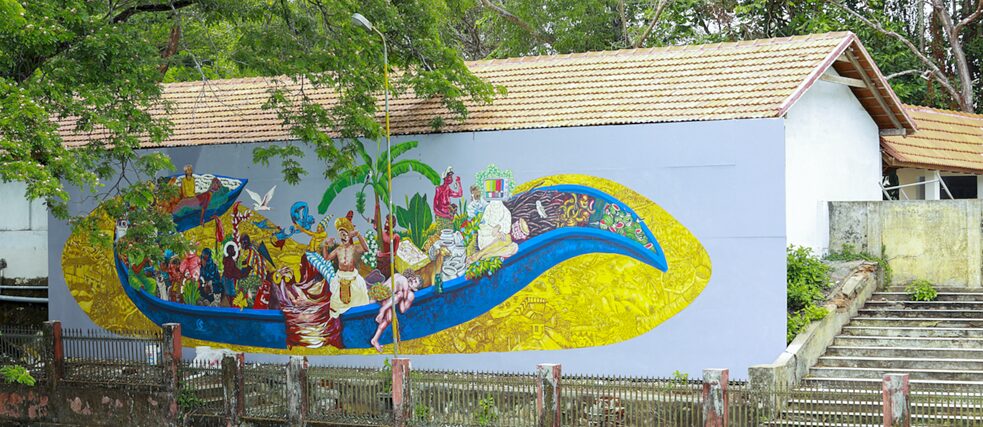A contemporary perspective
The Ascent of Visual Storytelling

The evolution of comics, graphic novel and street art in India echoes a fascinating journey of styles, thoughts, and ideas.
By Faizal Khan
When India's first biennale themed its second edition almost a decade ago on explorations that shaped the world, artists from both home and abroad responded enthusiastically, creating a cosmic canvas to shine a light on one thing that unites the land, water, and sky — travel. Among the works was a string of sketches straight out of the pages of a comic book illustrating the more than two millennia-old journeys between the East and the West. In the next edition, the Kochi-Muziris Biennale included a graphic novelist as a participating artist for the first time illuminating the contours of culture. It wasn't a random act that on both occasions street art filled the walls of the biennale venues.
In the artistic landscape of contemporary India, the rainbow layers of comics, graphic novels, and street art have become an integral part of popular culture. The last one decade has been a defining period in the evolution of all these three forms of visual art representations. At the biennale in Fort Kochi, Kerala, nonagenarian artist K M Vasudevan Namboothiri's comic strip-resembling drawings- captured the colonial history of the heritage town that is host to the contemporary art event. Graphic novelist Orijit Sen's tribute to the sparkle of life in a village of Rajasthan or a market in Goa or a city centre in Hyderabad interactively depicted at the biennale rendered an effusive tribute to people and places.
It has been a fascinating journey for comics in India which packs a strong oral and visual storytelling tradition across the vast expanse of a multitude of languages and cultures. Making a small beginning in the corner columns of weekend newspapers as superhero characters borrowed from abroad, the genre of comics has come a long way in the country. From stories of gods and goddesses, kings and courtiers, and warriors and jesters that have dominated the pages for decades creating generations of followers, Indian comics today are criss-crossed with a kaleidoscope of styles and ideas.
While homegrown superheroes have arrived to much fanfare, the growing attention of artists to exploring vital social aspects like diversity and inclusiveness and handling taboo subjects such as same-sex love and transgender life has energised the genre. The themes have resonated in such works as Amruta Patil's 'Kari' which deals with same-sex love and Bishakh Som's 'Spellbound - A Graphic Memoir' on transgender rights.
A new comic series in Hindi and English languages has a superhero called Dabung Girl, who is a little girl with an elastic body always ready to help the disadvantaged and the vulnerable. More and more comic books now lean their drawings towards gender equality, diversity, and respect for nature, elements that are increasingly becoming a vital part of contemporary comic strips, graphic novels, and street art in the country. Technology too has pitched in to take Indian comics to a new level. Last year, epics and folktales moved to blockchain-powered platforms, branding comics in a new avatar as non-fungible tokens (NFTs) for a society paralysed by the coronavirus pandemic.
The changes have been more discernible in graphic novels which made their entry into the country towards the end of the last century compared to the comics that came in the 1950s. Orijit Sen's 1994 work River of Stories, considered India's first graphic novel, portrayed the country's environmental concerns in a prescient warning of the climate catastrophe. Others that followed like Amruta Patil's Kari centred on LGBTQ rights, Prateek Thomas's Hush about violence against children, Jai Undurti's Hyderabad: A Graphic Novel about connecting Hyderabad and Hamburg through stories, Kalki Koechlin's The Elephant In The Womb on motherhood and Doab Dil by Sarnath Banerjee, a philosophical journey into the life of oddities have further cemented the status of the graphic novel in the country.
A latecomer to the comics entourage, street art in India has graduated from the early graffiti art associated with election campaigns to etch a name of its own in the history of visual storytelling. Since it first embraced the patchy walls of a south-west Delhi village over a decade-and-half ago, street art today has numerous practitioners and followers in India. Many art districts have sprung up in several states firmly establishing the genre's signature as a link between society and art. Soon after the Tokyo 2020 Olympics and Paralympics, street art practitioners in Delhi braved the pandemic to paint large portraits of all the members of the Indian contingent of paralympians on Metro pillars in the national capital in a tribute to their athleticism and spirit.
Street art works that came to their door became a balm for many Indians confined to their homes during a crushing pandemic when Covid-19 restrictions made movement almost impossible. A balm in the sense that the images of animals, buildings, rivers brought a colourful new world into their proximity, thus providing a much-needed relief from being confined to indoors. Those lucky to have colourful paintings on the walls of their housing quarters felt a gift of life in street art. In Alappuzha, a bustling port town in Kerala dotted with colonial-era coir warehouses and winding canals, artists painted a larger than life picture of a boat filled with people on the wall of a museum to remember the act of travelling, offering a visual memory through street art. Alappuzha's snake boat mural and a string of new art districts with street art springing up in places like Ukkadam in Tamil Nadu's Coimbatore and Lodhi Colony in Delhi offer a new direction to visual storytelling in the country.